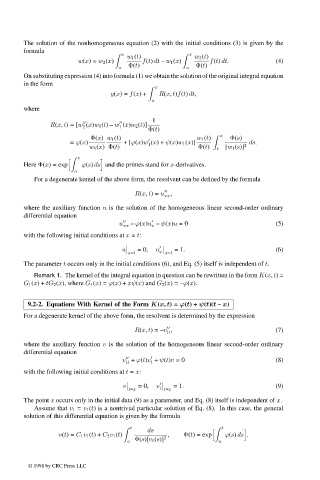Page 479 - Handbook Of Integral Equations
P. 479
The solution of the nonhomogeneous equation (2) with the initial conditions (3) is given by the
formula
x x
w 1 (t) w 2 (t)
w(x)= w 2 (x) f(t) dt – w 1 (x) f(t) dt. (4)
a Φ(t) a Φ(t)
On substituting expression (4) into formula (1) we obtain the solution of the original integral equation
in the form
x
y(x)= f(x)+ R(x, t)f(t) dt,
a
where
1
R(x, t)=[w (x)w 1 (t) – w (x)w 2 (t)]
1
2
Φ(t)
Φ(x) w 1 (t) w 1 (t) x Φ(s)
= ϕ(x) +[ϕ(x)w (x)+ ψ(x)w 1 (x)] ds.
1
w 1 (x) Φ(t) Φ(t) [w 1 (s)] 2
t
x
Here Φ(x)=exp ϕ(s) ds and the primes stand for x-derivatives.
a
For a degenerate kernel of the above form, the resolvent can be defined by the formula
R(x, t)= u ,
xx
where the auxiliary function u is the solution of the homogeneous linear second-order ordinary
differential equation
u xx – ϕ(x)u – ψ(x)u = 0 (5)
x
with the following initial conditions at x = t:
u =0, u = 1. (6)
x=t x x=t
The parameter t occurs only in the initial conditions (6), and Eq. (5) itself is independent of t.
Remark 1. The kernel of the integral equation in question can be rewritten in the form K(x, t)=
G 1 (x)+ tG 2 (x), where G 1 (x)= ϕ(x)+ xψ(x) and G 2 (x)= –ϕ(x).
9.2-2. Equations With Kernel of the Form K(x, t)= ϕ(t)+ ψ(t)(t – x)
For a degenerate kernel of the above form, the resolvent is determined by the expression
R(x, t)= –v , (7)
tt
where the auxiliary function v is the solution of the homogeneous linear second-order ordinary
differential equation
v + ϕ(t)v + ψ(t)v = 0 (8)
tt t
with the following initial conditions at t = x:
v =0, v = 1. (9)
t=x t t=x
The point x occurs only in the initial data (9) as a parameter, and Eq. (8) itself is independent of x.
Assume that v 1 = v 1 (t) is a nontrivial particular solution of Eq. (8). In this case, the general
solution of this differential equation is given by the formula
t ds t
v(t)= C 1 v 1 (t)+ C 2 v 1 (t) 2 , Φ(t)=exp ϕ(s) ds .
a Φ(s)[v 1 (s)] a
© 1998 by CRC Press LLC
© 1998 by CRC Press LLC
Page 461

